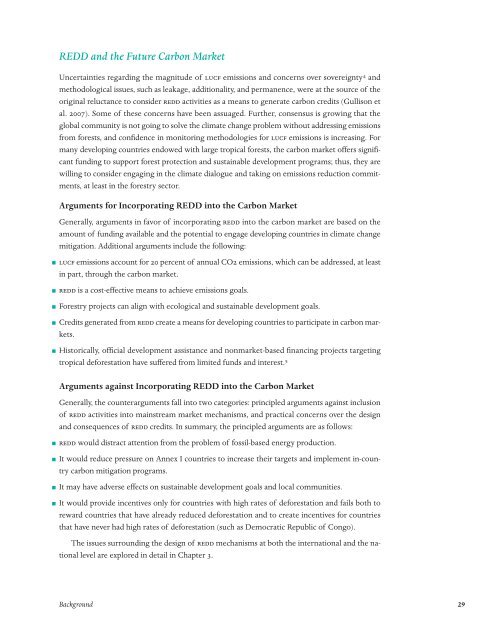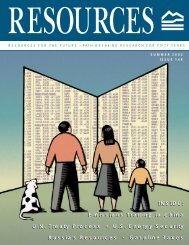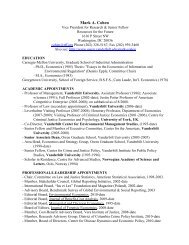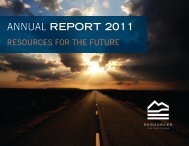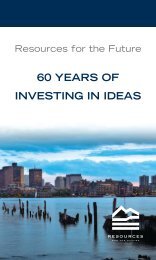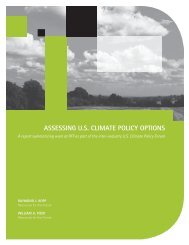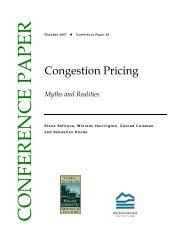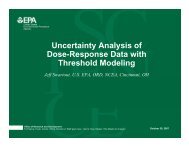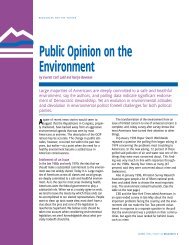Policies to Reduce Emissions from Deforestation and Degradation ...
Policies to Reduce Emissions from Deforestation and Degradation ...
Policies to Reduce Emissions from Deforestation and Degradation ...
You also want an ePaper? Increase the reach of your titles
YUMPU automatically turns print PDFs into web optimized ePapers that Google loves.
REDD <strong>and</strong> the Future Carbon Market<br />
Uncertainties regarding the magnitude of LUCF emissions <strong>and</strong> concerns over sovereignty 4 <strong>and</strong><br />
methodological issues, such as leakage, additionality, <strong>and</strong> permanence, were at the source of the<br />
original reluctance <strong>to</strong> consider REDD activities as a means <strong>to</strong> generate carbon credits (Gullison et<br />
al. 2007). Some of these concerns have been assuaged. Further, consensus is growing that the<br />
global community is not going <strong>to</strong> solve the climate change problem without addressing emissions<br />
<strong>from</strong> forests, <strong>and</strong> confidence in moni<strong>to</strong>ring methodologies for LUCF emissions is increasing. For<br />
many developing countries endowed with large tropical forests, the carbon market offers significant<br />
funding <strong>to</strong> support forest protection <strong>and</strong> sustainable development programs; thus, they are<br />
willing <strong>to</strong> consider engaging in the climate dialogue <strong>and</strong> taking on emissions reduction commitments,<br />
at least in the forestry sec<strong>to</strong>r.<br />
Arguments for Incorporating REDD in<strong>to</strong> the Carbon Market<br />
Generally, arguments in favor of incorporating REDD in<strong>to</strong> the carbon market are based on the<br />
amount of funding available <strong>and</strong> the potential <strong>to</strong> engage developing countries in climate change<br />
mitigation. Additional arguments include the following:<br />
∫ LUCF emissions account for 20 percent of annual CO2 emissions, which can be addressed, at least<br />
in part, through the carbon market.<br />
∫ REDD is a cost-effective means <strong>to</strong> achieve emissions goals.<br />
∫ Forestry projects can align with ecological <strong>and</strong> sustainable development goals.<br />
∫ Credits generated <strong>from</strong> REDD create a means for developing countries <strong>to</strong> participate in carbon markets.<br />
∫ His<strong>to</strong>rically, official development assistance <strong>and</strong> nonmarket-based financing projects targeting<br />
tropical deforestation have suffered <strong>from</strong> limited funds <strong>and</strong> interest. 5<br />
Arguments against Incorporating REDD in<strong>to</strong> the Carbon Market<br />
Generally, the counterarguments fall in<strong>to</strong> two categories: principled arguments against inclusion<br />
of REDD activities in<strong>to</strong> mainstream market mechanisms, <strong>and</strong> practical concerns over the design<br />
<strong>and</strong> consequences of REDD credits. In summary, the principled arguments are as follows:<br />
∫ REDD would distract attention <strong>from</strong> the problem of fossil-based energy production.<br />
∫ It would reduce pressure on Annex I countries <strong>to</strong> increase their targets <strong>and</strong> implement in-country<br />
carbon mitigation programs.<br />
∫ It may have adverse effects on sustainable development goals <strong>and</strong> local communities.<br />
∫ It would provide incentives only for countries with high rates of deforestation <strong>and</strong> fails both <strong>to</strong><br />
reward countries that have already reduced deforestation <strong>and</strong> <strong>to</strong> create incentives for countries<br />
that have never had high rates of deforestation (such as Democratic Republic of Congo).<br />
The issues surrounding the design of REDD mechanisms at both the international <strong>and</strong> the national<br />
level are explored in detail in Chapter 3.<br />
Background 2


